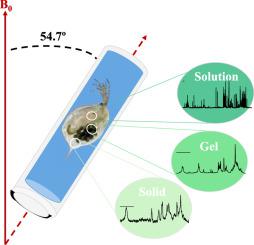当前位置:
X-MOL 学术
›
Anal. Chim. Acta X
›
论文详情
Our official English website, www.x-mol.net, welcomes your
feedback! (Note: you will need to create a separate account there.)
Ex vivo Comprehensive Multiphase NMR of Whole Organisms: A Complementary tool to in vivo NMR
Analytica Chimica Acta: X Pub Date : 2020-11-01 , DOI: 10.1016/j.acax.2020.100051 Rajshree Ghosh Biswas 1 , Blythe Fortier-McGill 1 , Mohammad Akhter 1 , Ronald Soong 1 , Paris Ning 1 , Monica Bastawrous 1 , Amy Jenne 1 , Daniel Schmidig 2 , Peter De Castro 2 , Stephan Graf 2 , Till Kuehn 2 , Falko Busse 3 , Jochem Struppe 4 , Michael Fey 4 , Hermann Heumann 5 , Holger Boenisch 5 , Marcel Gundy 5 , Myrna J Simpson 1 , André J Simpson 1
Analytica Chimica Acta: X Pub Date : 2020-11-01 , DOI: 10.1016/j.acax.2020.100051 Rajshree Ghosh Biswas 1 , Blythe Fortier-McGill 1 , Mohammad Akhter 1 , Ronald Soong 1 , Paris Ning 1 , Monica Bastawrous 1 , Amy Jenne 1 , Daniel Schmidig 2 , Peter De Castro 2 , Stephan Graf 2 , Till Kuehn 2 , Falko Busse 3 , Jochem Struppe 4 , Michael Fey 4 , Hermann Heumann 5 , Holger Boenisch 5 , Marcel Gundy 5 , Myrna J Simpson 1 , André J Simpson 1
Affiliation

|
Nuclear Magnetic Resonance (NMR) spectroscopy is a non-invasive analytical technique which allows for the study of intact samples. Comprehensive Multiphase NMR (CMP-NMR) combines techniques and hardware from solution state and solid state NMR to allow for the holistic analysis of all phases (i.e. solutions, gels and solids) in unaltered samples. This study is the first to apply CMP-NMR to deceased, intact organisms and uses 13C enriched Daphnia magna (water fleas) as an example. D. magna are commonly used model organisms for environmental toxicology studies. As primary consumers, they are responsible for the transfer of nutrients across trophic levels, and a decline in their population can potentially impact the entire freshwater aquatic ecosystem. Though in vivo research is the ultimate tool to understand an organism’s most biologically relevant state, studies are limited by conditions (i.e. oxygen requirements, limited experiment time and reduced spinning speed) required to keep the organisms alive, which can negatively impact the quality of the data collected. In comparison, ex vivo CMP-NMR is beneficial in that; organisms do not need oxygen (eliminating air holes in rotor caps and subsequent evaporation); samples can be spun faster, leading to improved spectral resolution; more biomass per sample can be analyzed; and experiments can be run for longer. In turn, higher quality ex vivo NMR, can provide more comprehensive NMR assignments, which in many cases could be transferred to better understand less resolved in vivo signals. This manuscript is divided into three sections: 1) multiphase spectral editing techniques, 2) detailed metabolic assignments of 2D NMR of 13C enriched D. magna and 3) multiphase biological changes over different life stages, ages and generations of D. magna. In summary, ex vivo CMP-NMR proves to be a very powerful approach to study whole organisms in a comprehensive manner and should provide very complementary information to in vivo based research.
中文翻译:

整个生物体的体外综合多相核磁共振:体内核磁共振的补充工具
核磁共振 (NMR) 光谱是一种非侵入性分析技术,可以研究完整的样品。综合多相 NMR (CMP-NMR) 结合了溶液态和固态 NMR 的技术和硬件,可以对未改变样品中的所有相(即溶液、凝胶和固体)进行整体分析。这项研究首次将 CMP-NMR 应用于已故、完整的生物体,并以 13C 富集 Daphnia magna(水蚤)为例。D. magna 是环境毒理学研究中常用的模式生物。作为初级消费者,它们负责营养物质在营养级上的转移,它们的数量减少可能会影响整个淡水水生生态系统。尽管体内研究是了解生物体与生物学最相关的状态的最终工具,但研究受到保持生物体存活所需的条件(即氧气需求、有限的实验时间和降低的旋转速度)的限制,这会对生物体的质量产生负面影响。收集到的数据。相比之下,离体 CMP-NMR 在这方面是有益的;生物体不需要氧气(消除转子盖上的气孔和随后的蒸发);样品可以更快地旋转,从而提高光谱分辨率;每个样品可以分析更多的生物量;并且实验可以运行更长时间。反过来,更高质量的离体 NMR 可以提供更全面的 NMR 分配,在许多情况下可以转移以更好地了解分辨率较低的体内信号。这份手稿分为三个部分:1) 多相光谱编辑技术,2) 富含 13C 的 D. magna 的 2D NMR 的详细代谢分配和 3) D. magna 不同生命阶段、年龄和世代的多相生物学变化。总之,离体 CMP-NMR 被证明是一种非常有效的方法来全面研究整个生物体,并且应该为基于体内的研究提供非常互补的信息。
更新日期:2020-11-01
中文翻译:

整个生物体的体外综合多相核磁共振:体内核磁共振的补充工具
核磁共振 (NMR) 光谱是一种非侵入性分析技术,可以研究完整的样品。综合多相 NMR (CMP-NMR) 结合了溶液态和固态 NMR 的技术和硬件,可以对未改变样品中的所有相(即溶液、凝胶和固体)进行整体分析。这项研究首次将 CMP-NMR 应用于已故、完整的生物体,并以 13C 富集 Daphnia magna(水蚤)为例。D. magna 是环境毒理学研究中常用的模式生物。作为初级消费者,它们负责营养物质在营养级上的转移,它们的数量减少可能会影响整个淡水水生生态系统。尽管体内研究是了解生物体与生物学最相关的状态的最终工具,但研究受到保持生物体存活所需的条件(即氧气需求、有限的实验时间和降低的旋转速度)的限制,这会对生物体的质量产生负面影响。收集到的数据。相比之下,离体 CMP-NMR 在这方面是有益的;生物体不需要氧气(消除转子盖上的气孔和随后的蒸发);样品可以更快地旋转,从而提高光谱分辨率;每个样品可以分析更多的生物量;并且实验可以运行更长时间。反过来,更高质量的离体 NMR 可以提供更全面的 NMR 分配,在许多情况下可以转移以更好地了解分辨率较低的体内信号。这份手稿分为三个部分:1) 多相光谱编辑技术,2) 富含 13C 的 D. magna 的 2D NMR 的详细代谢分配和 3) D. magna 不同生命阶段、年龄和世代的多相生物学变化。总之,离体 CMP-NMR 被证明是一种非常有效的方法来全面研究整个生物体,并且应该为基于体内的研究提供非常互补的信息。











































 京公网安备 11010802027423号
京公网安备 11010802027423号